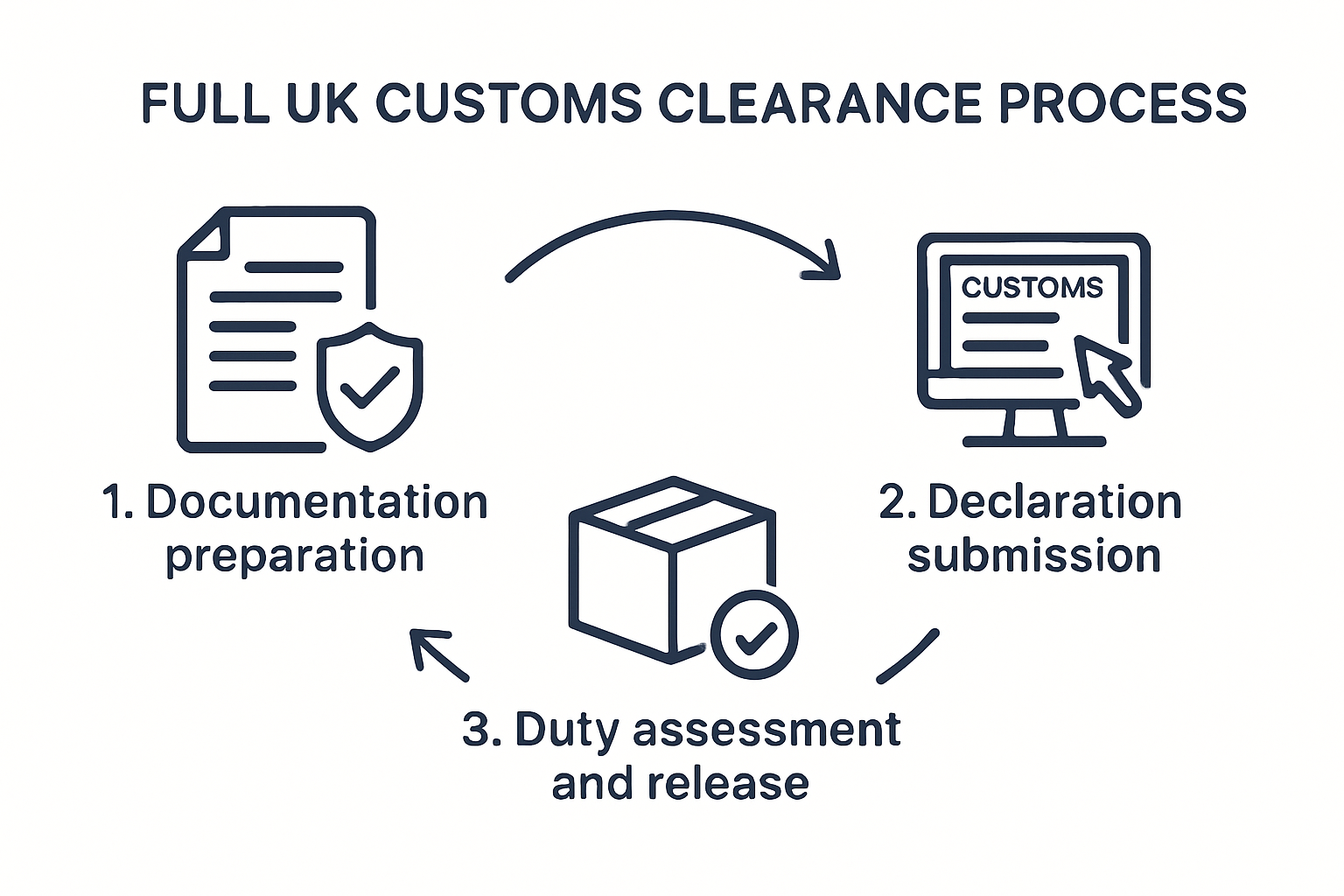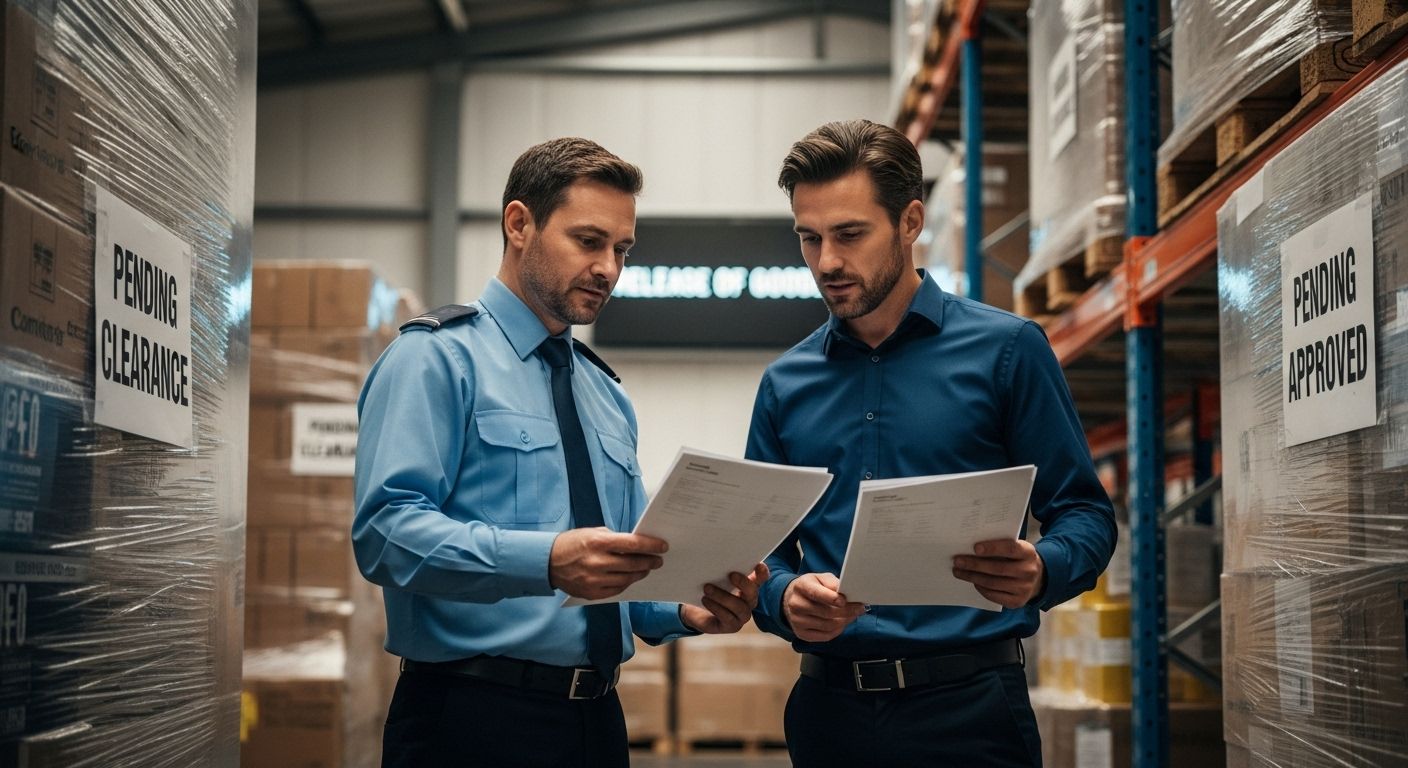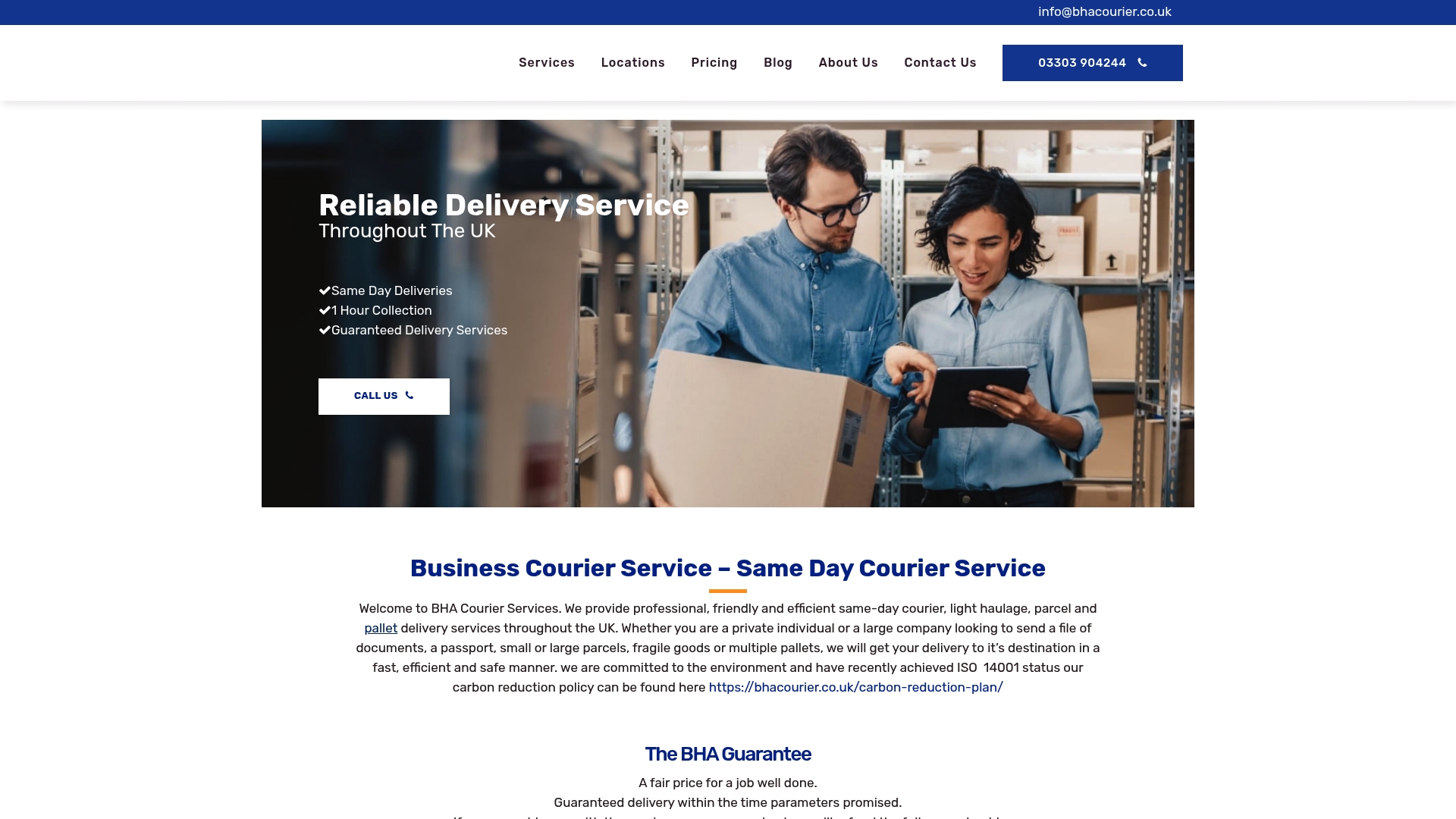
12 Aug What Is Customs Clearance? A Guide for UK Businesses
Customs clearance can seem like a maze for UK businesses dealing with international trade and every shipment is at risk if a single document is missing or incorrect. Nearly 30 percent of UK imports get delayed due to simple paperwork errors. Surprisingly, most companies think smooth shipping is just about packing boxes and sorting couriers. The real shock is that mastering customs clearance is what actually protects your goods and cashflow from unexpected fines and weeks-long holdups.
Table of Contents
- Understanding What Is Customs Clearance
- Step-By-Step Customs Clearance Process Explained
- Documents Needed For Smooth Customs Clearance
- Common Challenges And How To Avoid Delays
Quick Summary
| Takeaway | Explanation |
|---|---|
| Understand customs clearance thoroughly | Familiarity with customs processes is vital for UK businesses to navigate international trade successfully. |
| Prepare accurate documentation | Comprehensive and precise documentation prevents delays and costly penalties during the clearance process. |
| Obtain necessary licenses and codes | Ensure all regulatory permissions and commodity codes are in place to facilitate smooth customs approvals. |
| Anticipate potential inspection issues | Be prepared for customs inspections that can delay clearance; maintain clear and accurate records. |
| Invest in customs expertise | Employ customs specialists or brokerage services to streamline compliance and minimize logistical challenges. |
Understanding What Is Customs Clearance
Customs clearance represents a critical process for UK businesses engaged in international trade, serving as the essential gateway for goods to legally enter or exit a country. At its core, customs clearance involves a comprehensive series of administrative procedures and documentation requirements that ensure imported or exported goods comply with national regulations, taxation rules, and trade restrictions.
The Fundamental Components of Customs Clearance
Customs clearance is more than a simple administrative task – it is a complex process that involves multiple critical steps and stakeholders. Businesses must navigate a intricate landscape of documentation, tariff assessments, and regulatory compliance. According to HM Revenue & Customs, the process typically involves submitting detailed declarations about the nature, value, and origin of goods being transported across international borders.
The primary objectives of customs clearance include:
- Verify Goods Authenticity: Confirming the precise nature and classification of imported or exported items
- Calculate Appropriate Duties: Determining and collecting applicable taxes and tariffs
- Ensure Regulatory Compliance: Checking that goods meet all legal and safety standards for international trade
Documentation and Regulatory Requirements
Successful customs clearance hinges on meticulous documentation and understanding of international trade regulations. Businesses must prepare a comprehensive suite of documents, which typically include commercial invoices, certificates of origin, shipping manifests, and specific customs declaration forms. The World Customs Organization emphasizes that accurate and complete documentation is paramount to preventing delays, avoiding potential penalties, and ensuring smooth cross-border transactions.
For UK businesses, this means developing robust systems and processes that can efficiently manage the complex requirements of international trade. Errors or omissions in documentation can result in significant consequences, including shipment delays, financial penalties, and potential legal complications.
Navigating the intricacies of customs clearance requires a strategic approach. Businesses must stay informed about changing regulations, invest in proper training for staff handling international shipments, and potentially consider working with specialised customs brokerage services to streamline their international trade operations.
Understanding what is customs clearance goes beyond mere paperwork – it represents a critical component of global business strategy, requiring precision, knowledge, and careful attention to detail. For UK businesses looking to expand their international trade capabilities, mastering this process is not just recommended, but essential for sustainable growth and success in the global marketplace.
Step-by-Step Customs Clearance Process Explained
The customs clearance process is a structured journey that requires precision, attention to detail, and comprehensive understanding of international trade regulations. For UK businesses, navigating this process effectively can mean the difference between smooth international transactions and costly delays.
To help visualise the customs clearance process for UK businesses, here’s a step-by-step summary outlining each stage and its key actions:
| Step | Description |
|---|---|
| Preparing Documentation | Gather essential documents such as invoices, certificates of origin, and commodity codes |
| Pre-Clearance Requirements | Obtain necessary registrations like an EORI number for tracking international trade transactions |
| Submission of Customs Declaration | Electronically submit shipment details through the Customs Declaration Service (CDS) |
| Assessment by Customs Authorities | Authorities review declarations, assess duties/taxes, and may conduct risk assessments or inspections |
| Payment of Duties & Taxes | Settle any applicable charges promptly as requested by customs |
| Release of Goods | Customs approves and releases the goods for entry or exit |
Preparing Documentation and Pre-Clearance Requirements
Before goods can cross international borders, businesses must meticulously prepare a range of critical documentation. According to HM Revenue & Customs, the initial stage involves gathering essential documents that will support the customs declaration. These typically include:
- Commercial Invoice: Detailing the transaction value, description of goods, and parties involved
- Certificate of Origin: Proving the country where goods were manufactured
- Commodity Codes: Specific classification numbers that determine applicable duties and taxes
Businesses must also obtain an Economic Operator Registration and Identification (EORI) number, which is mandatory for companies engaging in import or export activities. UK Government Trade Guidelines emphasize the importance of this unique identifier in tracking and facilitating international trade transactions.
Submission and Assessment of Customs Declaration
Once documentation is prepared, businesses must submit a comprehensive customs declaration. This involves electronically filing detailed information about the shipment through the Customs Declaration Service (CDS) platform. The declaration includes critical information such as:
- Precise commodity descriptions
- Total shipment value
- Country of origin
- Applicable tariff classifications
Customs authorities will review the submitted declaration, assessing potential duties, taxes, and verifying compliance with import/export regulations. The World Customs Organization notes that this stage involves comprehensive risk assessment and potential physical inspections of goods.

Final Clearance and Release of Goods
The final stage of customs clearance involves payment of applicable duties and taxes, followed by the official release of goods. Businesses must be prepared to make immediate financial settlements and provide any additional documentation requested by customs officials. Delays can occur if there are discrepancies in documentation or unexpected compliance issues.

For businesses seeking to streamline their international shipping processes, understanding delivery manifests can provide additional insights into efficient logistics management. Successful customs clearance requires a strategic approach, combining thorough preparation, accurate documentation, and an understanding of complex international trade regulations.
Navigating the customs clearance process is not just about moving goods across borders – it is about building a robust, compliant international trade strategy that minimizes risks and maximizes operational efficiency. UK businesses that invest time in understanding and mastering these procedures will be better positioned to expand their global reach and maintain smooth international commercial relationships.
Documents Needed for Smooth Customs Clearance
Customs clearance demands a precise and comprehensive set of documents that serve as the foundation for legal international trade. UK businesses must understand and meticulously prepare these critical documents to ensure seamless cross-border transactions and avoid potential delays or penalties.
Here is a summary table of the main types of documents required for smooth customs clearance, grouped by their function and contents:
| Document Type | Purpose | Example Documents |
|---|---|---|
| Commercial | Verify transaction details and goods identity | Commercial Invoice, Packing List, Certificate of Origin |
| Regulatory/Compliance | Demonstrate legal and regulatory conformity | Import/Export Licences, Commodity Codes, Customs Value Declaration |
| Transportation/Insurance | Support shipment logistics and risk coverage | Bill of Lading, Airway Bill, Insurance Certificates |
This table helps clarify which documents UK businesses should prepare and their specific functions in the customs process.
Essential Commercial Documentation
The core of customs clearance documentation revolves around proving the authenticity, value, and legal compliance of goods being transported. According to HM Revenue & Customs, businesses must prepare several key documents that provide comprehensive details about their shipments.
The primary commercial documents include:
- Commercial Invoice: A detailed record of the transaction, including seller and buyer information, complete description of goods, total value, and payment terms
- Packing List: Precise inventory of the shipment, detailing item quantities, weights, and packaging specifications
- Certificate of Origin: Official document confirming the country where goods were manufactured, which significantly impacts duty calculations
Businesses must ensure these documents are not only accurate but also consistent across all paperwork. The World Customs Organization emphasizes that discrepancies between documents can trigger extensive inspections and potential shipment delays.
Regulatory and Compliance Documentation
Beyond commercial documents, businesses must provide additional regulatory documentation that demonstrates compliance with international trade regulations. These documents serve as critical proof of goods’ legitimacy and safety standards.
Key regulatory documents include:
- Import/Export Licenses: Official permissions required for specific types of goods
- Commodity Codes: Standardized classification numbers that determine applicable tariffs and potential restrictions
- Customs Value Declaration: Comprehensive statement detailing the precise value of goods for duty assessment
For businesses dealing with specialized or sensitive shipments, additional documentation might be necessary. Our guide on shipping hazardous materials provides further insights into the complex documentation requirements for high-risk cargo.
Supporting Transportation and Insurance Documentation
The final category of customs clearance documents involves transportation and insurance paperwork. These documents provide crucial information about the shipment’s journey and potential risk mitigation strategies.
Essential transportation documents include:
- Bill of Lading: Official record of goods being transported, serving as a receipt and contract
- Airway Bill: Similar to a bill of lading, but specifically for air freight shipments
- Insurance Certificates: Proof of cargo insurance coverage
Businesses must recognize that each document plays a crucial role in the customs clearance process. Understanding delivery manifests can provide additional context for how these documents work together to facilitate smooth international trade.
Navigating the complex world of customs documentation requires meticulous attention to detail, up-to-date knowledge of regulatory requirements, and a strategic approach to international shipping. UK businesses that invest time in understanding and properly preparing these documents will significantly reduce their risk of delays, penalties, and potential legal complications in cross-border trade.
Common Challenges and How to Avoid Delays
Customs clearance can present numerous challenges for UK businesses engaged in international trade. Understanding these potential obstacles and developing strategic approaches to mitigate them is crucial for maintaining smooth and efficient cross-border transactions.
Documentation and Compliance Pitfalls
Documentation errors represent the most frequent source of customs clearance delays. HM Revenue & Customs highlights that even minor inaccuracies can trigger extensive review processes, significantly prolonging shipment times. Common documentation challenges include:
- Incorrect Commodity Codes: Misclassifying goods can result in incorrect duty calculations and potential legal complications
- Incomplete Commercial Invoices: Missing or inconsistent transaction details can halt the entire clearance process
- Outdated Compliance Information: Failing to update documentation to reflect current international trade regulations
Businesses must implement rigorous document verification processes. This involves cross-checking all paperwork, maintaining up-to-date compliance knowledge, and potentially investing in specialized customs clearance software that can flag potential issues before submission.
Regulatory and Customs Inspection Challenges
Customs authorities conduct comprehensive risk assessments that can unexpectedly interrupt the clearance process. The World Customs Organization notes that shipments may be selected for detailed physical inspections based on various risk factors. These inspections can arise from:
- Suspicious commodity classifications
- Inconsistencies in declared value
- Random selection protocols
- High-risk origin countries
To mitigate these challenges, businesses should maintain transparent and accurate documentation, understand potential shipping delay causes, and develop contingency plans for potential extended clearance times.
Strategic Approaches to Minimizing Clearance Delays
Proactive management is key to navigating customs clearance challenges. Businesses can implement several strategic approaches to reduce potential delays:
- Advance Preparation: Complete and verify all documentation well before shipment
- Expert Consultation: Consider working with customs brokerage professionals
- Technology Integration: Utilize digital tools for real-time tracking and compliance monitoring
For businesses experiencing persistent shipping complications, understanding late delivery protocols can provide additional insights into managing unexpected clearance challenges.
Successful customs clearance requires a comprehensive approach that combines meticulous documentation, regulatory understanding, and proactive problem-solving. UK businesses that invest time in developing robust international trade processes will significantly reduce their risk of costly delays and potential legal complications.
Remember that customs clearance is not just a bureaucratic hurdle, but a critical component of international trade strategy. By anticipating potential challenges and developing strategic mitigation approaches, businesses can transform potential obstacles into opportunities for streamlined global commerce.
Frequently Asked Questions
What is customs clearance?
Customs clearance is a process that allows goods to legally enter or exit a country. It involves the submission of necessary documentation to customs authorities to ensure compliance with national regulations and taxation rules.
What documents are needed for customs clearance in the UK?
Essential documents include a commercial invoice, a packing list, a certificate of origin, import/export licences, commodity codes, and a customs value declaration. Each document serves a specific purpose in verifying the authenticity and compliance of goods.
How can UK businesses avoid delays during customs clearance?
To avoid delays, businesses should prepare accurate and complete documentation, keep up-to-date with regulatory requirements, anticipate potential inspections, and consider consulting with customs specialists or using customs clearance software.
What are common challenges faced during the customs clearance process?
Common challenges include documentation errors, incorrect commodity codes, incomplete invoices, and customs inspections. Each of these can lead to significant delays and potential penalties, making meticulous preparation essential.
Take the Stress Out of Customs Clearance with BHA Courier
Dealing with customs clearance can be overwhelming for your business. Missing documents, ever-changing regulations, or simple mistakes could lead to costly penalties and serious delays. If your business relies on efficient international shipping, you cannot afford these disruptions. With BHA Courier, you get more than just fast and secure parcel delivery. You benefit from a partner with the expertise to help you avoid the paperwork pitfalls and regulatory trouble described in our customs clearance guide.

Ready to experience truly seamless shipping? Choose a courier service trusted UK-wide for reliable, time-critical deliveries and help navigating every step of the process. Visit BHA Courier to learn how our same-day delivery solutions can keep your business moving. Book your next shipment today and make customs clearance one less worry for your team.
Recommended
- What Is a Delivery Manifest? Guide for UK Businesses 2025 – BHA Couriers
- Refusing a Delivery: Complete Guide for UK Businesses 2025 – BHA Couriers
- Consolidated Shipments for UK Businesses: Benefits and 2025 Guide – BHA Couriers
- Shipping Hazardous Materials in the UK: 2025 Guide for Businesses – BHA Couriers

Sorry, the comment form is closed at this time.